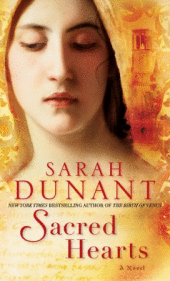To watch a video of Sarah talking about Sacred Hearts and to view a trailer for the book, click here.
 Imagine yourself in an old church in a town in northern Italy. The wall behind the altar is a grille too fine to see through, with a small opening, just large enough to let a chalice pass through. Now close your eyes. On the other side you hear a shuffling of feet, a cough, the clearing of throats. An organ sounds a couple of notes. You are about to hear the voices of a choir of enclosed nuns...
Imagine yourself in an old church in a town in northern Italy. The wall behind the altar is a grille too fine to see through, with a small opening, just large enough to let a chalice pass through. Now close your eyes. On the other side you hear a shuffling of feet, a cough, the clearing of throats. An organ sounds a couple of notes. You are about to hear the voices of a choir of enclosed nuns...Bringing history to life depends on many things. Once you've done the research and found your story, you then have to paint it in Technicolor. It's a writer's job to use words to make pictures, but when it comes to the past, they need to be the kind you can walk into, a virtual reality of the senses. In Florence, where I wrote The Birth of Venus, I used to wander dark alleyways in the middle of the night noting the way voices might bounce up off a canyon of high buildings, disturbing the peace as powerfully as they would have done five centuries before. In Venice, where I set In the Company of the Courtesan, the water was my sensual gateway. When it was hot, even without the sewage of the great Renaissance city, the canals stank, and when the fog came down sound played such mad tricks that my own footsteps would become an errant heartbeat tracking me from behind.
When I started Sacred Hearts the challenge was greater because the history was more hidden. In the late 16th century, huge numbers of women --- almost half of the daughters of noble Italian families --- were in convents from the age of 15 until their death. Their lives were ruled by ritual and repetition: eating, working and of course praying, even in the middle of the night. How could I bring alive this strangest of all strange existences?
In retreat at a convent near Milan my senses did some of the work for me. After a week I was so tired during the night service that my mind started wandering. Turn off the heating, take away the electric lights, add a few days' fasting and who knows what images the darkness might conjure up. Ferrara, where I set my story, had once been full of convents. Most are long gone and the two that remain are "clausura," which means you cannot go further in than the nuns' chapel. Remains of convent architecture, however, are everywhere: walls, churches, gardens and the most exquisite collection of cloisters, with the tread of a million footsteps on the stone stairs, the swish of robes, the ghosts of a hundred veiled figures.
Then there was the singing. Ferrara was a great musical centre, known for its composers and concerts, even down to the appearance of castrati as the newest fashion of the day. And the convents were renowned for their choirs of angels. The more I read, the more enthralled I became. Inside those walls, it seemed, were nuns who wrote music and played instruments, while their performances were said to make the hair on the back of your neck stand on end.
That was when I found Musica Secreta: a group of English women singers who researched the hidden history of nuns' choirs. When I heard their recordings and watched them perform I understood something I had never realised before: that whatever those women felt about their incarceration (and many were there against their will), there was a deep pleasure and satisfaction to be had in the making of the music itself. In an environment where so many kinds of sensuality were forbidden, there was always the possibility of opening your mouth and feeling your voice mingle and soar... even if you might want to fall asleep during the night service.
At the end of my research I went back to the convent that had inspired my story. The old nun who showed me the chapel this time told me that they still performed Vespers and that I could sit in the outer church and listen. Sacred Hearts was almost finished by then. I was so excited. In my mind I had filled this church on both sides of the grille.
In the public church I sat with four others as the nuns shuffled out. When the organ sounded I closed my eyes. The thin, reedy voices of seventeen older women straggled out through the grille, some with barely enough vocal power to hold the phrases to the end. By the time they had finished, three of the other listeners had left. I didn’t know whether to laugh or cry. Thank heaven for history. At least we can still imagine what we have lost.
---Sarah Dunant

